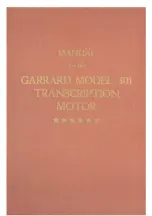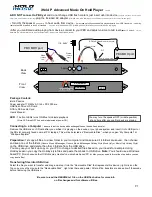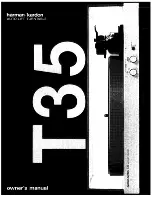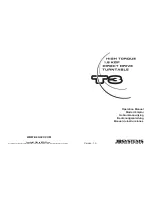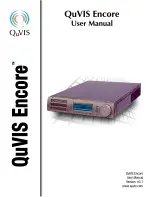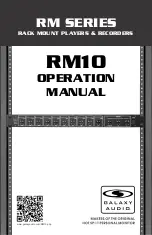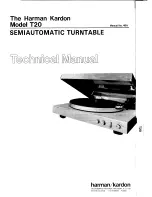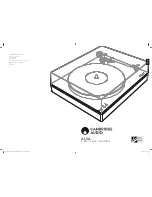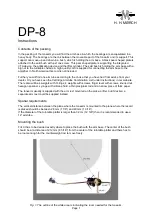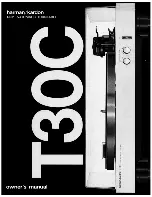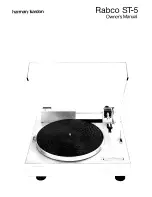
adjustable tracking force holding it
down, so the moving parts should be
as light as possible in order to ensure
that they can move quickly. The total
apparent
mass of the parts that are
being moved as a result of the groove
modulation is called the
e
ff
ective tip
mass
. Intuitively, this can be thought
of as giving an impression of the
amount of inertia in the stylus.
It is important to not confuse the
tracking force and the e
ff
ective tip
mass, since these are very di
ff
erent
things. Imagine a heavy object like a
1500 kg car, for example, lifted o
ff
the
ground using a crane, and then slowly
lowered onto a scale until it reads 1 kg.
The “weight” of the car resting on the
scale is equivalent to 1 kg. However, if
you try to push the car sideways, you
will obviously find that it is more
di
ffi
cult to move than a 1 kg mass,
since you are trying to overcome the
inertia of all 1500 kg, not the 1 kg that
the scale “sees”. In this analogy, the
reading on the scale is equivalent to
the Tracking Force, and the mass that
you’re trying to move is the E
ff
ective
Tip Mass. Of course, in the case of a
phonograph stylus, the opposite
relationship is desirable; you want a
tracking force high enough to keep the
stylus in the groove, and an e
ff
ective
tip mass as close to 0 as possible, so
that it is easy for the groove to move it.
3.7 Compliance
Imagine an audio signal that is on the
left channel only. In this case, the
variation is only on one of the two
groove walls, causing the stylus tip to
ride up and down on those bumps. If
the modulation velocity is high, and
the e
ff
ective tip mass is too large, then
the stylus can lift o
ff
the wall of the
groove just like a car leaving the
surface of a road on the trailing side of
a bump. In order to keep the car’s
wheels on the road, springs are used to
push them back down before the rest
of the car starts to fall. The same is
true for the stylus tip. It’s being
pushed back down into the groove by
the cantilever that provides the spring.
The amount of “springiness” is called
the
compliance
of the stylus
suspension. (Compliance is the
opposite of spring sti
ff
ness: the more
compliant a spring is, the easier it is to
compress, and the less it pushes back.)
Like many other stylus parameters, the
compliance is balanced with other
aspects of the system. In this case it is
balanced with the e
ff
ective mass of the
tonearm (which includes the tracking
force
), resulting in a resonant
frequency. If that frequency is too high,
then it can be audible as a tone that is
“singing along” with the music. If it’s
too low, then in a worst-case situation,
the stylus can jump out of the record
groove.
If a turntable is very poorly adjusted,
then a high tracking force and a high
stylus compliance (therefore, a “soft”
spring) results in the entire assembly
sinking down onto the record surface.
However, a high compliance is
necessary for low-frequency
reproduction, therefore the maximum
tracking force is, in part, set by the
compliance of the stylus.
If you are comparing the specifications
of di
ff
erent cartridges, it may be of
interest to note that compliance is
often expressed in one of five di
ff
erent
units, depending on the source of the
information:
•
“Compliance Unit” or “cu”
•
mm/N
millimetres of deflection per
Newton of force
•
µ
m/mN
micrometres of deflection per
thousandth of a Newton of force
•
x 10
−
6
cm/dyn
hundredths of a micrometre of
deflection per dyne of force
•
x 10
−
6
cm/10
−
5
N
hundredths of a micrometre of
deflection per hundred-
thousandth of a Newton of force
Since
•
mm/N = 1000
µ
m / 1000 mN
•
1 dyne = 0.00001 Newton
Then this means that all five of these
expressions are identical, so, they can
be interchanged freely. In other words:
20 CU
= 20 mm / N
= 20
µ
m / mN
= 20 x 10
−
6
cm / dyn
= 20 x 10
−
6
cm / 10
−
5
N
3.8 Soundsmith SMMC20CL
Today, the Beogram 4000c is supplied
with an SMMC20CL cartridge made by
Soundsmith. This is a nude contact line
diamond stylus with a solid sapphire
cantilever. It is a variable reluctance
design, based on the original Bang &
Olufsen Micro Moving Cross
construction.
The SMMC20CL has an e
ff
ective tip
mass of 0.32 mg, lower than the 0.5
mg of the original MMC 4000 cartridge,
but slightly higher than the 0.22 mg in
the MMC 6000 cartridge.
8
On the Mechanics of Tonearms, Dick Pierce
13




















